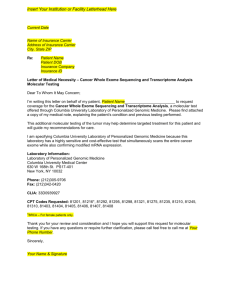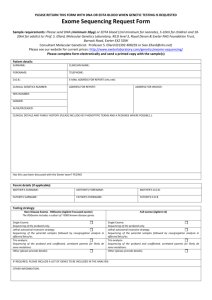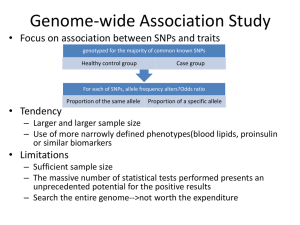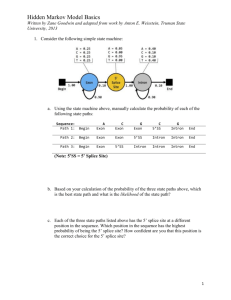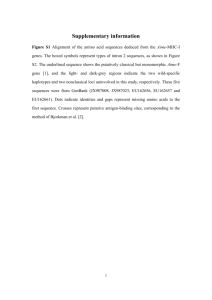tpj12601-sup-0006-Legends
advertisement
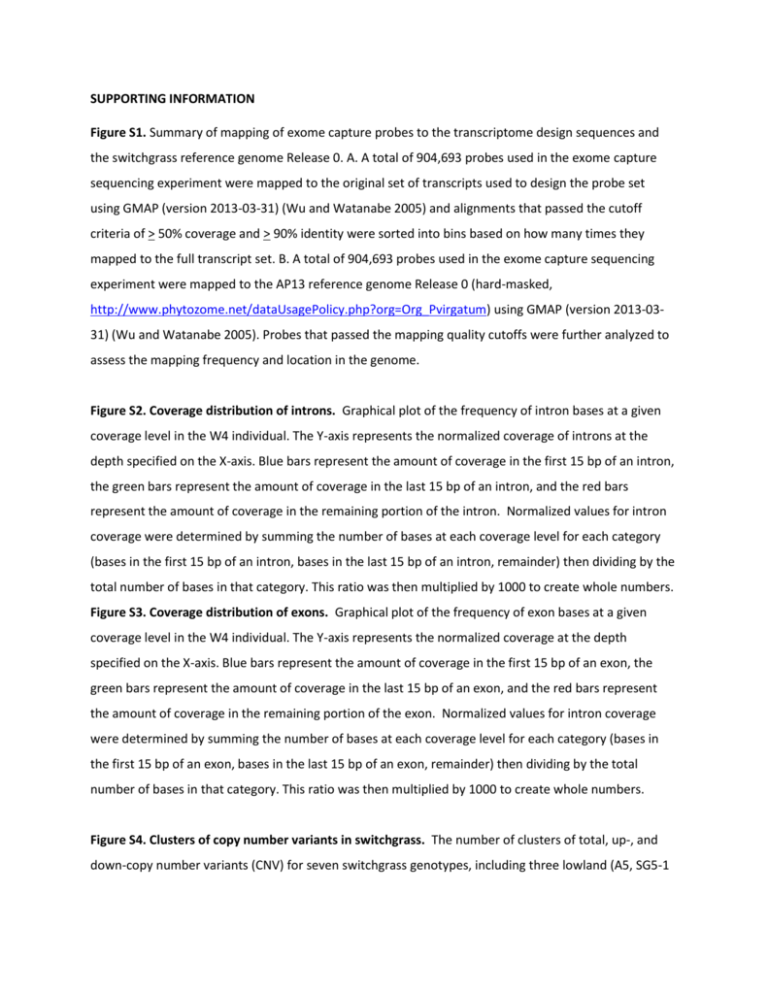
SUPPORTING INFORMATION Figure S1. Summary of mapping of exome capture probes to the transcriptome design sequences and the switchgrass reference genome Release 0. A. A total of 904,693 probes used in the exome capture sequencing experiment were mapped to the original set of transcripts used to design the probe set using GMAP (version 2013-03-31) (Wu and Watanabe 2005) and alignments that passed the cutoff criteria of > 50% coverage and > 90% identity were sorted into bins based on how many times they mapped to the full transcript set. B. A total of 904,693 probes used in the exome capture sequencing experiment were mapped to the AP13 reference genome Release 0 (hard-masked, http://www.phytozome.net/dataUsagePolicy.php?org=Org_Pvirgatum) using GMAP (version 2013-0331) (Wu and Watanabe 2005). Probes that passed the mapping quality cutoffs were further analyzed to assess the mapping frequency and location in the genome. Figure S2. Coverage distribution of introns. Graphical plot of the frequency of intron bases at a given coverage level in the W4 individual. The Y-axis represents the normalized coverage of introns at the depth specified on the X-axis. Blue bars represent the amount of coverage in the first 15 bp of an intron, the green bars represent the amount of coverage in the last 15 bp of an intron, and the red bars represent the amount of coverage in the remaining portion of the intron. Normalized values for intron coverage were determined by summing the number of bases at each coverage level for each category (bases in the first 15 bp of an intron, bases in the last 15 bp of an intron, remainder) then dividing by the total number of bases in that category. This ratio was then multiplied by 1000 to create whole numbers. Figure S3. Coverage distribution of exons. Graphical plot of the frequency of exon bases at a given coverage level in the W4 individual. The Y-axis represents the normalized coverage at the depth specified on the X-axis. Blue bars represent the amount of coverage in the first 15 bp of an exon, the green bars represent the amount of coverage in the last 15 bp of an exon, and the red bars represent the amount of coverage in the remaining portion of the exon. Normalized values for intron coverage were determined by summing the number of bases at each coverage level for each category (bases in the first 15 bp of an exon, bases in the last 15 bp of an exon, remainder) then dividing by the total number of bases in that category. This ratio was then multiplied by 1000 to create whole numbers. Figure S4. Clusters of copy number variants in switchgrass. The number of clusters of total, up-, and down-copy number variants (CNV) for seven switchgrass genotypes, including three lowland (A5, SG5-1 and W4) and four upland ecotypes (Car1, She2, Tr5 and P2). The total number of clusters for each genotype is listed at the top of the bar. Table S1. Number of raw Illumina reads and reads that passed quality control. Table S2. Exome capture read alignment statistics. Table S3. Single nucleotide polymorphisms identified in eight switchgrass genotypes. This file is available for download from the Dryad Digital Repository (http://datadryad.org/) at this DOI (http://doi.org/10.5061/dryad.b52p5). Column headers identify genotype whereas the final column (HQ_SNP) indicates whether locus is present in the high-quality single nucleotide polymorphism set. Table S4. Genes identified with up-copy number variants in seven switchgrass genotypes using exome capture sequencing. Table S5. Genes identified with down-copy number variants in seven switchgrass genotypes using exome capture sequencing. Table S6. Genes with presence/absence variants identified in seven switchgrass genotypes identified by exome capture sequencing. Table S7. Enrichment of Pfam domains in lowland ecotype up-CNVs. Table S8. Enrichment of Pfam domains in upland ecotype up-CNVs. Table S9. Enrichment of Pfam domains in lowland ecotype down-CNVs. Table S10. Enrichment of Pfam domains in upland ecotype down-CNVs. Table S11. Enrichment of Pfam domains in lowland ecotype PAVs. Table S12. Enrichment of Pfam domains in upland ecotype PAVs. Table S13. Genes with higher than expected SNP density (>1 standard deviation higher than mean) identified in eight switchgrass genotypes by exome capture sequencing. Table S14. Pfam domains and P-values for genes with high-density single nucleotide polymorphism density.
